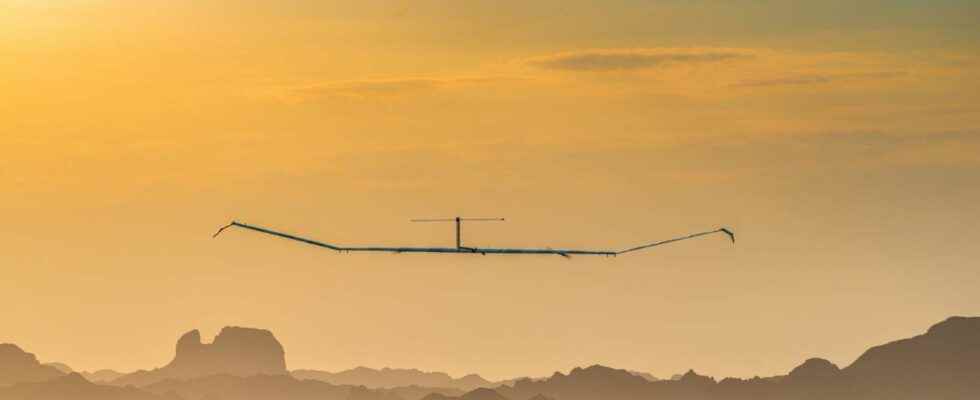You will also be interested
[EN VIDÉO] A medical drone to transport blood samples We have already seen drones capable of delivering medical equipment or medicines, but what about blood samples? According to a study by Johns Hopkins (USA) and Makerere (Uganda) universities, this would be possible. Here is the progress of a flight in video.
the Zephyr Airbus continues to accumulate world records. After climbing to an altitude of 21,915 meters and completing an already record flight of 26 consecutive days, the drone stratospheric solar-electric, has just added ten more days to its record on behalf of theArmy Futures Command (AFC) which manages military modernization projects. After taking theair on June 15, the drone flew at an altitude of more than 21,300 meters above Arizona in the United States. L’aircraft of 28 meters wingspan which weighs 75 kg can carry a load of 5 kg and it is theoretically able to stay in the air for months, well above the air traffic and the vagaries of the weather.
The Airbus Zephyr is the first solar electric stratospheric drone. © Airbus Defense and Space
First and foremost military objectives
The purpose of the device is to replace satellites over a monitoring area of 20-30 km. the drone can be enriched with sensors radar, lidar and infrared. It is of great interest to the military, for whom it would make it possible to replace satellites in the event of a faulty link in order to keep surveillance and communication capacities operational. During these tests, the plane which should be totally autonomous was flown via a relationship satellite. In addition to this flight, another test will be carried out in the coming weeks to fly over the Pacific Ocean with a payload. It will then be a question of wearing military equipment to ensure communication tests between multiple American command centers.
Zephyr: a world altitude record for the Airbus stratospheric drone
The Airbus Zephyr solar drone is accumulating records. During its last operational validation tests, it managed to reach an altitude of 23,915 meters.
Article by Sylvain Biget, published on
He gate better and better its name of “pseudolite”, the contraction of pseudo and satellite. After achieving record duration 26-day flight, the Zephyr of Airbus rose to an altitude of 23,915 meters, in the sky of Arizona (United States). For the aircraft manufacturer, it was a question of carrying out the last test flights of the aircraft so that it could obtain its status as an operational aircraft. With its wings spanning 28 meters and a mass of 75 kg, including 24 kg of batteries charged by vast solar panels positioned on its wings, it can carry a payload of 5 kg.
During the tests, the drone stratospheric solar-electric was therefore able to evolve according to several configurations with different payloads, test its optical systems, its maneuverability in the stratosphere and its ability to align itself precisely to points on the ground. These flights also secured approval from the US Federal Aviation Agency (FAA) to fly in the territory’s airspace. This validation is important because, to place oneself above the commercial air trafficthe drone must be able to cross it in semi-autonomous mode.
It can replace satellites
The tests were also an opportunity to test an Opaz system as a payload. This equipment is designed by Airbus to carry out missions ofearth observation from the stratosphere. With his big electro-optical sensors (18 cm) and infrared (70 cm), the device delivers precise images and videos of the Planet. In all, during its tests, Zephyr S will have flown for 2,435 hours in the stratosphere. During its last flights, the drone held in the air for 18 days, to accumulate 887 hours of flight. The tests ended a month ago.
Depending on the payload it hosts, the device can be dedicated to many apps. It is thus able to cover large geographical areas in telephony mobile. According to Airbus, it could also replace the equivalent of 250 cellular antennas. It is also capable of carrying out environmental and border surveillance missions. It is of particular interest to the military and in particular the British Ministry of Defence, which is its main client. The latter envisages the Zephyr as a replacement for links satellite lost in order to keep its communication and surveillance networks operational.
This solar-powered stratospheric drone can replace satellites by performing environmental monitoring missions.
A desire to escape for the summer?
To celebrate the holidays as it should be, discover the Mag Futura at the preferential price of €15 instead of €19, i.e. a reduction of 20% !
On the program of this issue: a dive into the heart of 4 scientific themes that will mark 2022, from the Earth to the Moon:
- What mysteries does the Moon still hide from us?
- Will we soon be able to cure everything thanks to genes?
- How to feed the world without destroying it?
- Can artificial intelligence become truly intelligent?
What is Mag Futura?
- Our first paper journal of more than 200 pages to make science accessible to as many people as possible
- 4 major scientific questions for 2022, from the Earth to the Moon
- Home delivery*
*Delivery is made in France (excluding metropolitan France), Switzerland, Belgium.
Interested in what you just read?
